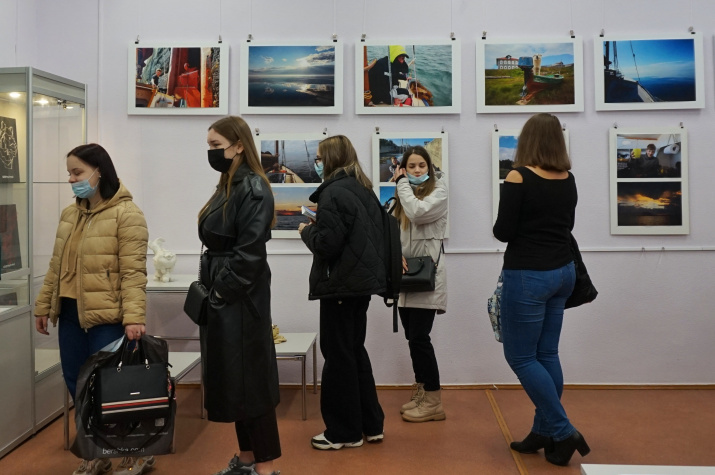On September 14, the Institute of Creative Industries and Entrepreneurship of the MASU hosted the opening of the exhibition of photographs taken by Alexander and Igor Loginov. The photos were taken during an expedition to the Barents and White seas, which took place with the information support from the Murmansk Regional Branch of the Russian Geographical Society and scientific support from the Murmansk Marine Biological Institute of the Russian Academy of Sciences (MMBI RAS). The exhibition's main goal was to assess the pollution levels of the Barents and White seas’ beaches in July 2021.
Alexander Loginov, a student of Lyceum No. 1, told about the preparation and implementation of the project: "We built the boat inside the building, in an office space, then we took it to the Severomorsk Yacht Club, where it is based now. The expedition was inspired by the following phenomenon – on the map of plastic pollution compiled by New Zealand designers, the western part of the Barents Sea is full of dots indicating waste, but in the eastern part there are practically none. This could be explained by two hypotheses: according to the first, plastic is brought by the North Atlantic Current, which makes a turn in the area of Novaya Zemlya and carries all the waste back to the ocean. According to the second theory, too few expeditions have been conducted to assess the pollution of the Barents Sea."
This is how the project began. Alexander and Igor Loginov built a wooden sailing boat. Igor Loginov is a member of the Murmansk Regional Branch of the RGS.
Alexander and his father conducted three environmental surveys, visited Arkhangelsk and the Solovetsky Islands, sailed along the White Sea-Baltic Canal, reached Lake Onega and Kizhi Island. The analysis of beach pollution was carried out according to the methodology provided by the MMBI RAS within the framework of the Russian-Norwegian MALINOR project. Alexander and Igor landed on the shore, marked an area of land 10 meters wide extending from the water line to the beginning of the vegetation cover. Then they collected the waste and sorted it into three categories – plastic, glass and metal. Then they recorded the results to create a map of plastic pollution, which will later on be transferred to the MMBI RAS for analysis and study.
Denis Moiseev: "The expedition was supposed to take place last year, but due to covid restrictions, it was possible to organize only a reconnaissance trip to the sea. This year, we managed to fully implement the original plan, and travel from Severomorsk to Lake Onega through the Barents Sea, the White Sea and the White Sea-Baltic Canal".
The opening of the exhibition was also attended by the member of the Council of the Murmansk Regional Branch of the RGS Sergey Goncharov, project manager of the Murmansk Regional Branch of the RGS Anastasia Yagodina, as well as representatives of one of the Russian Navy units, Alexandra Sokolova and Alexander Altunin.
Zoya Zhelnina: "Traveling in the Arctic always seems very difficult, something that someone else is doing. But in fact, if you set a goal, you can always go on a journey. A small journey around the house to the nearest lake or, conversely, a very long journey. I am always pleased that all these trips have a scientific basis, they always refer, for example, to historical maps and expeditions. I am always very happy when they end with such a presentation".
After the speech, Denis Moiseev presented Alexander Loginov with memorable gifts from the Murmansk Regional Branch of the RGS.



